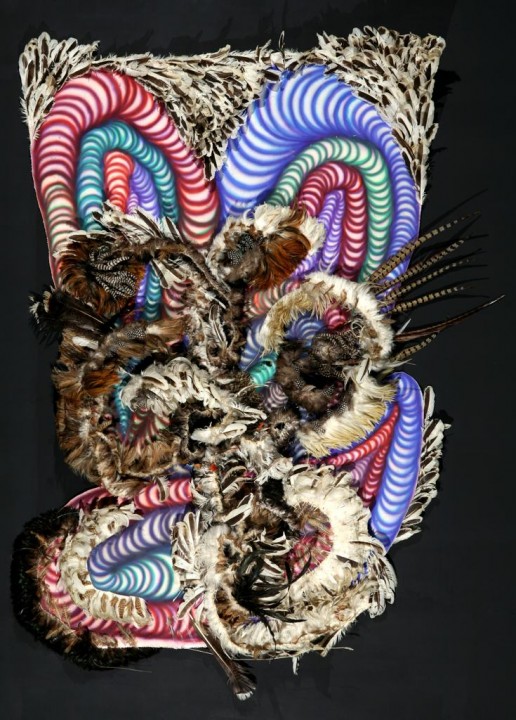
Mask – Unmask
Feathers, acrylic on unstretched canvas
For nearly fifty years Carlos Villa has explored the meaning of cultural diversity in his art and in doing so has expanded our awareness of what we consider as ‘multicultural.’ What began in his early career as an attempt to understand his own heritage – a complexity of Filipino traditions with its layered strains of Asian, African, Indian, and Oceanic cultures, along with influences of a Western artistic tradition – became over time, an exercise in creating his own visual anthropology representing his personal background, and, in a broader sense, the dynamics of true intercultural weaving.
The greater body of Villa’s art has been an exploration of cultural identity. He freely appropriated and assimilated imagery, traditional materials, and ideas from his own Filipino heritage as he reinvented a cultural vocabulary for Filipino Americans one step removed from the source of such a rich culture. It is the same impetus that moved him to pioneer the study of Filipino and Filipino American art history. Works such as Coat (1979), drew inferences between ceremonial attire, cultural artistry, and the role of a twentieth-century artist-as-shaman in re-presenting an old culture to new generations. Villa furthered this transcultural connection between tradition and artistic reinvention in a series of performance art pieces, such as Ritual (1980), in which the artist absorbed and enacted the essence of cultural shamanism, translating it in to an act of aesthetic experience.
Concurrent with these widely celebrated explorations of heritage and art, Villa was also creating a body of work less culturally identifiable, but no less pertinent to the individual. This work was much more minimal in nature: not minimalist as an adherent of a particular school of art, but minimal as a means of seeking the essence of humanity beneath the over-layering of cultural identity. The aesthetic results are both more challenging to read, and more relevant to the universal experience of being human.
Villa’s installation of works at the Triton Museum of Art consists of a series of finely crafted cabinets, each containing a grid of assembled panels. Their presentation is clean, precise, and, as in all of Villa’s work, laden with conceptions of history, time, relations, and the meaning of cultural identity and human experience. Each cabinet is made of wood and hinged so that its contents can be hidden from view, or open to examination. In this they are akin to a medieval altarpiece or a Joseph Cornell assemblage box. The interior panels, assembled and unified, though still separate, are the treasures contained inside their wooden reliquaries, awaiting the understanding of the viewer, should she or he be desirous of receiving its mysteries.
The panel blocks arranged inside the open book-like cases form a community of interdependent units. In each community there are interplays of lines made from the actual separation and joining of the panels, and lines artificially etched on to their surfaces. As the artist suggests, these lines may represent the delineation of time between events, space between dates, or geographic and cultural separation between people. Yet across these lines flows the inherent grain of the various woods, forming complex patterns of natural similarities that transcend the artificial boundaries of separation. We are left to ponder what kind of wood is used, its color, the presence or absence of applied patina like the external layering of separate cultural identities, and the complexity of grain densities suggesting the deeper core of shared human nature. Human identity, be it individual or as a member of a community, is to the artists, the essence of what matters most. It is this essence that is given visual voice and treasured in its own altarpiece cabinet(s). If Villa’s cultural explorations are a guide for those outside of that particular heritage to understand ‘the Other,’ then this body of work represents the artist’s attempt to help us understand ourselves on a universal level. The assembled panels are a visual metaphor, and Villa is the poet of that vision.
Accompanying this latest work are three series of photographs documenting some of the artist’s earlier universal explorations of humanity through his own minimalist vocabulary. Together with the newer cabinet pieces, they provide a more complete view of Villa’s attempts to portray what he sees as the essence of the human experience.
In addition to an extensive exhibition career, Carlos Villa is a noted historian, activist, and lecturer. He currently teaches art at the San Francisco Art Institute and at the University of San Francisco.
– Preston Fletcher (view article)
www.Carlos-Villa.com
Download CV [pdf]
Keywords: Filipino-American, interdisciplinary, men, painting, sculpture


